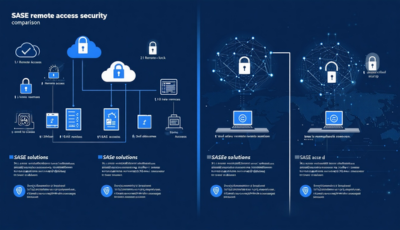As organizations race toward digital transformation, they’re rethinking everything from customer experience to IT infrastructure. At the heart of this shift is network modernization—a strategic overhaul designed to support agility, cloud adoption, and increasingly remote workforces. For many enterprises, SD-WAN (software-defined wide area networking) seemed like the perfect upgrade. But as digital demands evolve, it’s becoming clear that SD-WAN may not be the full answer.
SD-WAN was initially hailed as a cost-effective, flexible replacement for traditional MPLS networks, offering faster WAN connections across branch locations and improved internet connectivity. But the reality is more nuanced. When it comes to enabling full-scale digital transformation, SD-WAN shows its limitations—especially around security, cloud readiness, and performance under pressure.
Where SD-WAN Falls Short in Network Modernization
A recent industry report titled “Networking in 2020: Understanding Digital Transformation’s Impact on IT Confidence in Enterprise Networks” surveyed over 1,300 IT professionals on the state of enterprise networking. One of the most revealing findings? Organizations that had deployed SD-WAN expressed significantly less confidence in their network's ability to support digital transformation compared to those using newer frameworks like SASE (Secure Access Service Edge).
1. Lack of Cloud-Native Support
Modern networks are no longer tethered to a central data center. Enterprises rely on cloud-based applications, edge services, and remote teams operating from virtually anywhere. Yet SD-WAN was never designed for seamless cloud integration. While it can route traffic to cloud providers, it lacks native support for cloud services, often requiring third-party workarounds or additional software layers.
The disadvantages of SD-WAN in this context are clear: it introduces unnecessary complexity, increases the need for management tools, and makes it harder to ensure consistent application performance across cloud environments. In fact, 69% of SD-WAN users reported decreased confidence in their network’s cloud capabilities post-implementation.
2. Security Limitations and Risk Exposure
Security is another major pain point. SD-WAN solutions do not inherently include the robust, centralized management of security policies needed for today’s threat landscape. Features like firewall integration, intrusion detection, and real-time threat protection must often be layered on manually.
Only 37% of IT professionals in the survey said that SD-WAN effectively protected against modern security threats such as malware and ransomware attacks. That’s a sobering stat—especially when 66% of respondents said that defending against these threats was one of their biggest network security challenges.
The rise in remote and hybrid work has only intensified these concerns. Managing mobile access, applying corporate policies to personal devices, and safeguarding distributed data flows are outside SD-WAN’s core capabilities. For enterprises focused on network modernization, this leaves a glaring vulnerability.
3. Insufficient Support for Mobility and Flexibility
Today’s network users don’t sit at a desk from 9 to 5. They’re working across time zones, devices, and platforms. A modern work arrangement depends on flexible, secure network infrastructure that adapts to shifting traffic patterns and user demands.
Yet SD-WAN isn’t inherently designed for mobile-first enterprises. 52% of IT leaders said they struggled to enforce corporate security policies for mobile users through their SD-WAN solutions. This gap becomes even more critical when supporting cloud-first strategies, where users must access SaaS tools and internal systems from multiple locations in real time.
4. Complexity in Scaling and Operations
While SD-WAN can deliver cost savings and quicker site deployment compared to MPLS, it introduces operational complexity—especially at scale. Large organizations may face challenges with based networking, traffic prioritization, and maintaining visibility across a growing number of endpoints.
Network modernization requires more than adding software overlays. It demands an end-to-end transformation that enables centralized orchestration, automated policies, and AI-powered analytics. Many SD-WAN solutions require bolting on extra tools to approximate this functionality, which erodes the simplicity and manageability that modernization efforts strive for.
Why SASE May Be the Future of Modern Networking
It’s no surprise that enterprises using SASE frameworks reported higher confidence in their network’s ability to support digital transformation. SASE combines SD-WAN capabilities with cloud-native security, delivering a unified approach that aligns better with the realities of modern IT.
With SASE, security and networking converge at the edge, where traffic enters or exits the enterprise. This approach improves visibility, reduces the attack surface, and simplifies policy enforcement—all while supporting fast, reliable access to cloud-based resources. It’s a model purpose-built for the hybrid, decentralized, and dynamic environments that define today’s business landscape.
Is SD-WAN Still Useful?
Absolutely. For some organizations, SD-WAN still offers value—especially those seeking to move away from rigid, expensive MPLS connections. When implemented thoughtfully, SD-WAN can improve performance, add flexibility, and reduce reliance on legacy wide area network infrastructure.
But it shouldn’t be mistaken for a complete modernization strategy. The disadvantages of SD-WAN—from cloud integration challenges to security limitations—are too significant to ignore. And for enterprises with their sights set on future-proofing their operations, the gap between what SD-WAN delivers and what’s truly needed is growing.
Final Thoughts: Rethink Your Network Modernization Strategy
Network modernization is not just a buzzword—it’s a critical transformation that can determine your enterprise’s agility, competitiveness, and security posture in a rapidly evolving digital world. SD-WAN may still play a role in that journey, but it’s not the whole story.
To stay ahead, enterprises need to evaluate networking solutions not just by cost or convenience, but by their ability to support the future of work, cloud scalability, and ever-evolving security demands.
At ITBroker.com, we help businesses assess their networking needs with a clear, expert-driven approach. Whether you’re evaluating SD-WAN, considering a shift to SASE, or rethinking your entire WAN strategy, we’ll connect you to the right solution—with the right partners—at the right cost.
Ready to modernize your network? Let’s talk.






